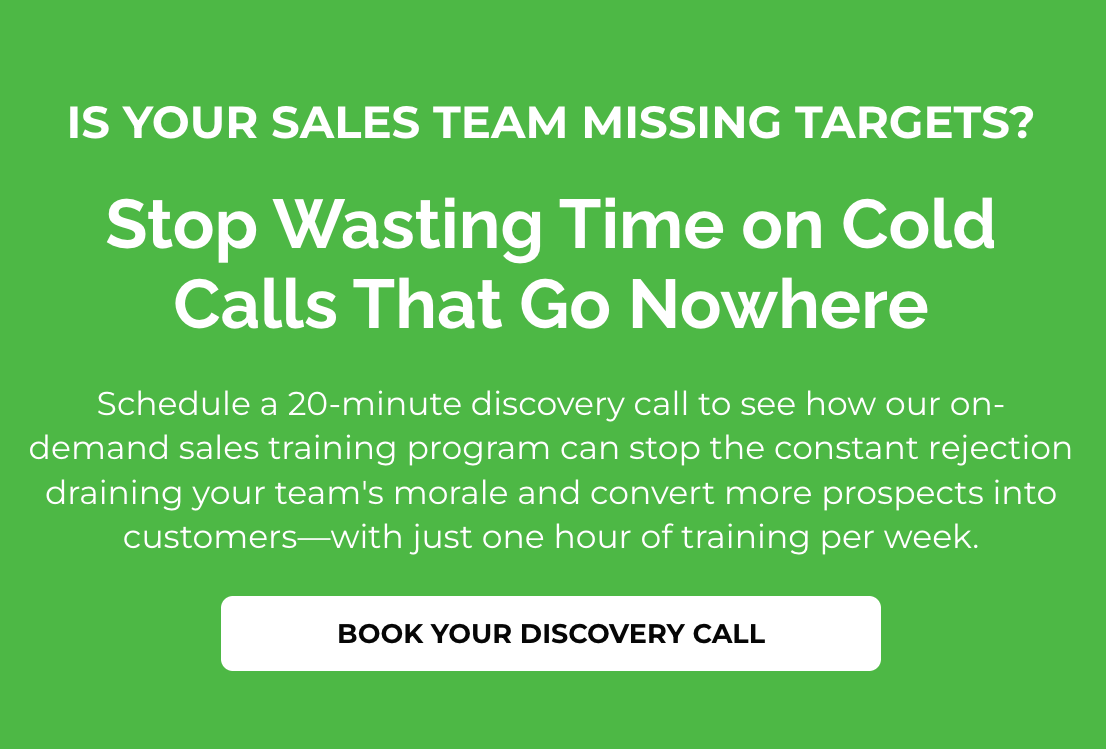The Missing Piece to Your Outbound Sales Cadence

The Best Outbound Sales Cadences Can Cause Complacency
Here’s how to solve that.
Everyone is always searching for the best outbound sales cadence – but what if following a cadence causes business development reps to become complacent?
One of the critical factors as to why the outbound sales model has worked in the past has to do with the business development reps’ sense of urgency.
Most inside sales reps started on straight commission (present company included). If they didn’t sell, they didn’t eat.
Most of today’s inside sales reps have a generous base salary ($43,697 on average, according to Glassdoor) plus bonuses for hitting quota.
In addition to their salary, the tech stack available these days is a godsend.
The O.G.’s (Original Gangsters) of Inside Sales had the following:
- A desk
- A chair
- A phone
- A phonebook
Today’s inside sales reps have (and I’m sure I’m missing a few things)
- Work from home option
- $200 headset
- Laptop
- CRM
- UpLead
- Marketing Automation
- Lead Enrichment Automation
- Zoom
- Calendly / TimeTrade / ScheduleOnce
It’s an excellent time to be selling over the phone. There are more sales tools available now than ever to help a motivated self-starter become wildly successful.
So why is it then that a large amount of inside sales reps are missing quota?
According to a recent Harvard Business Review survey, “60% of salespeople achieved quota last year.” That sounds great to some – but indeed not the business owners, directors, or managers. 40% didn’t produce the expected revenue.
If half of the 40% hit their numbers, the additional revenue could have a significant impact on the health of a company. And everyone needs to work at a healthy company if they want to sleep well at night.
So, what does this have to do with Sales Cadences and Lead Management?
I’ve noticed a trend in today’s inside sales world – a trend where a “sense of urgency to move the prospect forward” is missing.
Sales Cadence and lead management may be part of the problem, but they can also be part of the solution by making a minor adjustment.
Allow me to explain.
Keep in mind what I am about to say isn’t across the board for all sales teams. However, some small business owners or V.P., Directors, or sales managers may have already noticed the complacency following a sales cadence can bring and have already made the necessary adjustments. Bravo to them!
So this is for everyone else…
The 60-Day Rule
The best outbound sales cadence I’ve ever had was simple. Once you took ownership of a lead, you had 60-days to move the needle, or another sales rep could take the account.
And when I say “take,” I don’t mean “hey, can you assign that account over to me?”
I mean, take as is in on the 60th day, another sales rep can log in and change the lead owner status into their name.
It’s called “The 60-day rule,” and it was invented by the best sales manager I ever had.
So, how does this work, and how would it fit in with today’s outbound sales cadence playbooks?
It’s simple. When you add the “60-day rule”, you automatically increase the sense of urgency in your sales reps.
They’ll want to be a little better when they get the prospect on the phone, a little sharper in asking questions to identify pain points, and be a little more willing to “hang in there” after the first and second “no” on the sales call.
The last thing any sales rep wants to do is warm up a cold call to lose the sales down the road to another sales rep that swoops in and closes the deal.
By adding the 60-Day Rule to your outbound sales cadence playbook, you invite an atmosphere of purpose from the sales team. Fear of loss has proven repeatedly to be an effective way to encourage others to do what you need them to do.
And all companies, from Solopreneurs to Fortune 500, need sales. So the sales engine of a company is its lifeblood.
High email open rates are nice stats, but they don’t pay the bills.
It would be best if you had a sales team that has a sense of urgency. Going through the motions of a sales cadence is not as effective as having the possible loss of that account if the rep doesn’t make significant progress with the prospect.
“What happens if some progress is made, but the deal isn’t closed within the 60-days?
The 60-Day Rule resets itself every time a significant step/communication happens between the lead owner and the prospect.
The purpose of the 60-day Rule is two-fold:
- Close more deals sooner
- Avoid losing revenue by not allowing reps to hoard accounts
“What if we have super-long sales cycles? Our average deal takes 12 to 18 months to close.”
You adjust the 60-Day Rule based on your sales cycle. So if a deal typically takes 12-months, there should be active movement at least every 90-days, as an example.
“Another sales rep took my account, but I just made a note last week that the prospect is still interested. Shouldn’t the 60-Day Rule have been reset?”
There has to be a solid development in the stage of the sales process for the 60-day Rule to be “reset.” Unfortunately, too many salespeople have tried to game the system with the just “checking-in” sales touch to try and reset the 60-Day Rule.
Of course, any discrepancy should be resolved by the sales manager.
Let me know if you have questions.
P.S… Be a sniper when it comes to taking over leads by setting reminders the day before and accounting for months with “31-days” in them 🙂
– Michael Pedone
Michael Pedone teaches inside sales teams how to pick up the phone and close business. He is the CEO/FOUNDER of SalesBuzz.com – An online sales training company.

